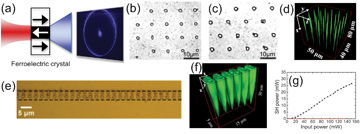 (a) Tightly focused, ultrashort light pulses locally reverse ferroelectric domain in the focal volume, which can be monitored in real time with the appearance of a conical Cherenkov second-harmonic signal. (b and c) Optical microscopic images of the resulting ferroelectric domain patterns in z-cut lithium niobate. (d) 3-D visualization of optically inverted domains in x-cut lithium niobate. (e and f) Optical and Cherenkov microscopic images of the domain pattern fabricated in a channel waveguide in z-cut lithium niobate. (g) The measured power of the second harmonic (λ = 407 nm) versus the power of the fundamental wave.
(a) Tightly focused, ultrashort light pulses locally reverse ferroelectric domain in the focal volume, which can be monitored in real time with the appearance of a conical Cherenkov second-harmonic signal. (b and c) Optical microscopic images of the resulting ferroelectric domain patterns in z-cut lithium niobate. (d) 3-D visualization of optically inverted domains in x-cut lithium niobate. (e and f) Optical and Cherenkov microscopic images of the domain pattern fabricated in a channel waveguide in z-cut lithium niobate. (g) The measured power of the second harmonic (λ = 407 nm) versus the power of the fundamental wave.
Ferroelectric domain patterns are essential for a variety of applications, including frequency conversion, optical beam shaping, high-density data storage and memories, quantum information processing and more.1 Recently, we have developed a method that employs femtosecond infrared laser pulses for ferroelectric domain patterning, and overcomes many disadvantages of alternative methods.2,3
Typically, domain patterns are produced using electric field poling (EFP) with patterned electrodes and high voltage. This technique, however, suffers from low resolution and can predominantly be used in only one crystallographic orientation—a significant disadvantage, since many devices require other crystallographic orientations, such as electro-optic modulators in lithium niobate, where an x-cut crystal is favored.
One proposed solution to these drawbacks has been all-optical poling, which uses focused UV light whose absorption induces a high temperature gradient and subsequent domain reversal via a thermoelectric field.4 Unfortunately, for ferroelectric crystals, UV poling is effective only at the very surface due to inherent strong absorption, and surface damage often accompanies domain reversal, eliminating use in optical waveguides or thin films.
The infrared method we have now developed relies on nonlinear absorption of light in the optical beam’s focal volume. That, in turn, induces a high temperature gradient and appearance of a thermoelectric field that locally inverts the direction of the spontaneous polarization (see figure). The method can form long domains, extending from the surface up to 100 µm deep in the crystal; applies to different crystallographic orientations; and offers spatial resolution of around 1.0 µm. It also does not induce surface damage, and hence can be applied to optical waveguides, thin films and ferroelectric-crystal membranes.
As an example, we were able to fabricate a periodic, quasi-phase-matching structure in a lithium niobate channel waveguide, and to achieve efficient second-harmonic generation at λ = 815 nm, with 17.5 percent conversion efficiency. Femtosecond pulse poling opens up the possibility to realize true 3-D domain patterning in the bulk of ferroelectric crystals.
Researchers
X. Chen, V. Shvedov, P. Karpinski, and Y. Sheng, Australian National University, Canberra, Australia
K. Koynov, Max-Planck Institute for Polymer Research, Mainz, Germany
A. Boes and A. Mitchell, ARC Centre for Ultrahigh Bandwidth Devices for Optical Systems (CUDOS), RMIT University, Melbourne, Australia
J. Trull and C. Cojocaru, Universitat Politecnica de Catalunya, Barcelona, Spain
W. Krolikowski, Australian National University, Canberra, Australia and Texas A&M University at Qatar, Doha, Qatar
References
1. P. Ferraro et al. Ferroelectric Crystals for Photonic Applications, Springer (2009).
2. X. Chen et al. Appl. Phys. Lett. 107, 141102 (2015).
3. X. Chen et al. Opt. Lett. 41, 2410 (2016).
4. J. C.Y.J. Ying et al. Laser Photon. Rev. 6, 526 (2012).
